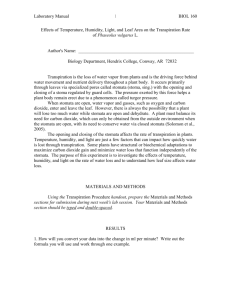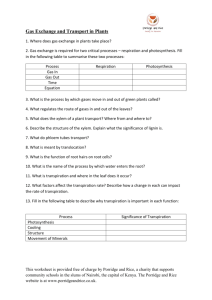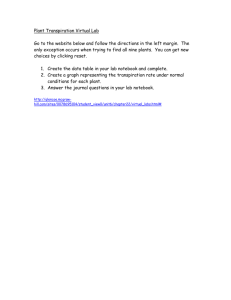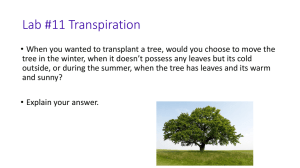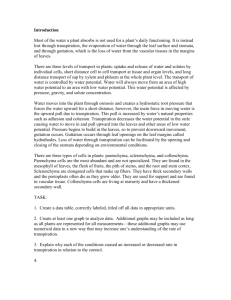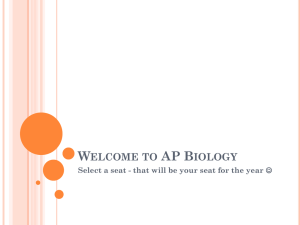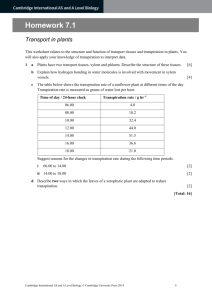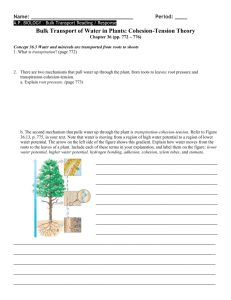AP Biology Lab 11: Transpiration
advertisement
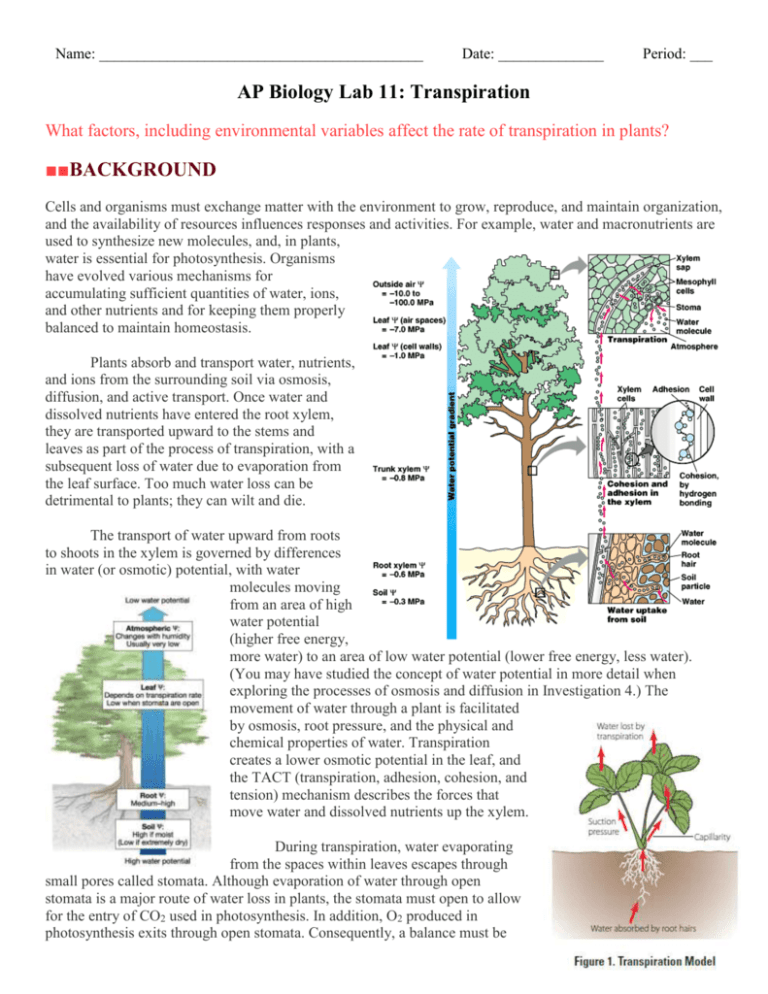
Name: ___________________________________________ Date: ______________ Period: ___ AP Biology Lab 11: Transpiration What factors, including environmental variables affect the rate of transpiration in plants? ■■BACKGROUND Cells and organisms must exchange matter with the environment to grow, reproduce, and maintain organization, and the availability of resources influences responses and activities. For example, water and macronutrients are used to synthesize new molecules, and, in plants, water is essential for photosynthesis. Organisms have evolved various mechanisms for accumulating sufficient quantities of water, ions, and other nutrients and for keeping them properly balanced to maintain homeostasis. Plants absorb and transport water, nutrients, and ions from the surrounding soil via osmosis, diffusion, and active transport. Once water and dissolved nutrients have entered the root xylem, they are transported upward to the stems and leaves as part of the process of transpiration, with a subsequent loss of water due to evaporation from the leaf surface. Too much water loss can be detrimental to plants; they can wilt and die. The transport of water upward from roots to shoots in the xylem is governed by differences in water (or osmotic) potential, with water molecules moving from an area of high water potential (higher free energy, more water) to an area of low water potential (lower free energy, less water). (You may have studied the concept of water potential in more detail when exploring the processes of osmosis and diffusion in Investigation 4.) The movement of water through a plant is facilitated by osmosis, root pressure, and the physical and chemical properties of water. Transpiration creates a lower osmotic potential in the leaf, and the TACT (transpiration, adhesion, cohesion, and tension) mechanism describes the forces that move water and dissolved nutrients up the xylem. During transpiration, water evaporating from the spaces within leaves escapes through small pores called stomata. Although evaporation of water through open stomata is a major route of water loss in plants, the stomata must open to allow for the entry of CO2 used in photosynthesis. In addition, O2 produced in photosynthesis exits through open stomata. Consequently, a balance must be maintained between the transport of CO2 and O2 and the loss of water. Specialized cells called guard cells help regulate the opening and closing of stomata. In this laboratory investigation, you will begin by calculating leaf surface area and then determine the average number of stomata per square millimeter. From your data, several questions emerge about the process of transpiration in plants, including the following: • Do all plants have stomata? Is there any relationship between the number of stomata and the environment in which the plant species evolved? • Are leaf surface area and the number of stomata related to the rate of transpiration? What might happen to the rate of transpiration if the number of leaves or the size of leaves is reduced? • Do all parts of a plant transpire? • Do all plants transpire at the same rate? Is there a relationship between the habitat in which plants evolved and their rate of transpiration? • What other factors, including environmental variables, might contribute to the rate of transpiration? • What structural features and/or physiological processes help plants regulate the amount of water lost through transpiration? How do plants maintain the balance between the transport of CO2 and O2 and the amount of water lost through transpiration? You will then design an experiment to investigate one of these questions or a question of your own. As a supplemental activity, you can examine microscopically thin sections of stems, identify xylem and phloem cells, and relate the function of these vascular tissues to observations made about the structure of these cells. The investigation also provides an opportunity for you to apply and review concepts you have studied previously, including the relationship between cell structure and function; osmosis, diffusion, and active transport; the movement of molecules and ions across cell membranes; the physical and chemical properties of water; photosynthesis; and the exchange of matter between biological systems and the environment. Figure 2: A stomatal pore in the surface (epidermis) of a leaf as viewed through a microscope. The central stomatal pore is formed by a pair of guard cells. The stomatal pore can either open (left) or close (right) depending on the environmental condition. ■■ FURTHER BACKGROUND Transpiration, the loss of water by plants, occurs mainly through the stomata of the leaves. Water can move up a plant to the leaves by being pushed from the bottom or pulled from the top. Root pressure is not sufficient to push water all the way from the bottom to the top of a large plant such as a tree. It is more likely that water is pulled through the plant by the cohension-tension mechanism. As water leaves the intercellular space between the mesophyll cells in the leaf and evaporates through the stomata, it is replaced by water from within the cells themselves. Since water moves out of these cells freely but solutes do not, the solute concentration within the mesophyll cells increases and the water potential of the cells decreases. Water will then move into the mesophyll cells from surrounding cells with higher water potentials, for example, the cells of the xylem. Thus, as a result of transpiration, a gradient of differences in water potential from the xylem to the air outside the leaf is formed - water tends to move upward. Transpiration pulls on the fluid within the xylem causing tension (negative pressure) to form in the xylem, pulling the walls of the xylem inward. Tension, since it is negative pressure, causes water potential in the xylem to decrease. The decrease in water potential transmitted through the Figure 3. Ion channels and pumps regulating stomatal opening and closure. column of fluid in the xylem, all the way to the roots, causes water to move from the soil across the cortex of the root and into the xylem of the stele. The opening of stomata allows transpiration to occur. It is also required for the entry of carbon dioxide used in photosynthesis. Conversely, it is an escape route for the oxygen produced from the splitting of water. A balance must be maintained between the processes, transpiration and photosynthesis through careful regulation of the stomata and the guard cells that flank them. What would happen were oxygen or carbon dioxide to build up inside plant tissues? ■■Learning Objectives 1. To investigate the relationship among leaf surface area, number of stomata, and the rate of transpiration 2. To design and conduct an experiment to explore other factors, including different environmental variables, on the rate of transpiration 3. To investigate the relationship between the structure of vascular tissues (xylem and phloem) and their functions in transporting water and nutrients in plants ■■General Safety Precautions Be good. Be kind. Take care of the messes you make. Clean up after each other. Leave the lab in better condition than the condition in which you found it! ■■Getting Started: Answer the following questions in the space provided and include this information in you lab notebook write-up. These questions are designed to help you understand concepts related to transpiration in plants before you design and conduct your investigation(s). 1. If a plant cell has a lower water potential than its surrounding environment, make a prediction about the movement of water across the cell membrane. In other words, will the cell gain water or lose water? Explain your answer in the form of a diagram with annotations. 2. In the winter, salt is sometimes spread over icy roads. In the spring, after the ice has melted, grass often dies near these roads. What causes this to happen? Explain your answer in the form of a diagram with annotations. 3. Prepare a thin section of stem from your plant and examine it under the microscope to identify the vascular tissues (xylem and phloem) and the structural differences in their cells. (Or, much easier, ask Mr. Schuster for a prepared slide.) Describe how the observed differences in cellular structure reflect differences in function of the two types of vascular tissue. 4. If you wanted to transplant a tree, would you choose to move the tree in the winter, when it doesn’t possess any leaves but it’s cold outside, or during the summer, when the tree has leaves and it’s warm and sunny? Explain your answer. ■■THE INVESTIGATIONS ■■Guided Procedure Materials • Living representative plant species available in your region/season, such as Impatiens (a moisture-loving plant), Coleus, oleander (more drought tolerant), Phaseolus vulgaris (bean seedlings), pea plants, varieties of Lycopersicon (tomato), peppers, and ferns • Calculator, microscope, microscope slides, clear cellophane tape, clear nail polish, and scissors • Additional supplies that you might need after you choose a method to determine leaf surface area (Step 1 below). Ask Mr. Schuster for advice. Record data and any answers to questions in your lab notebooks, as instructed by Mr. Schuster. Step 1 Form teams of two or three and investigate methods of calculating leaf surface area. (You will need to calculate leaf surface area when you conduct your experiments.) Think about and formulate answers to the following questions as you work through this activity: a. How can you calculate the total leaf surface area expressed in cm2? In mm2? b. How can you estimate the leaf surface area of the entire plant without measuring every leaf? c. What predictions and/or hypotheses can you make about the number of stomata per mm2 and the rate of transpiration? d. Is the leaf surface area directly related to the rate of transpiration? e. What predictions can you make about the rate of transpiration in plants with smaller or fewer leaves? f. Because most leaves have two sides, do you think you have to double your calculation to obtain the surface area of one leaf? Why or why not? g. Water is transpired through stomata, but carbon dioxide also must pass through stomata into a leaf for photosynthesis to occur. There is evidence that the level of carbon dioxide in the atmosphere has not always been the same over the history of life on Earth. Explain how the presence of a higher or lower concentration of atmospheric carbon dioxide would impact the evolution of stomata density in plants. h. Based on the data in the following table, is there a relationship between the habitat (in terms of moisture) to which the plants are adapted and the density of stomata in their leaves? What evidence from the data supports your answer? Step 2 Make a wet mount of a nail polish stomatal peel to view leaf epidermis using the following technique: a. Obtain a leaf. (The leaf may remain on the plant or be removed.) b. Paint a solid patch of clear nail polish on the leaf surface being studied. Make a patch of at least one square centimeter. c. Allow the nail polish to dry completely. d. Press a piece of clean, clear cellophane tape to the dried nail polish patch. Using clear (not opaque) tape is essential here. You might also try pulling the peel away from the leaf without using any tape and then preparing a wet mount of the peel with a drop of water and a cover slip. e. Gently peel the nail polish patch from the leaf by pulling a corner of the tape and peeling the nail polish off the leaf. This is the leaf impression that you will examine. (Make only one leaf impression on each side of the leaf, especially if the leaf is going to be left on a live plant.) f. Tape the peeled impression to a clean microscope slide. Use scissors to trim away any excess tape. Label the slide as appropriate for the specimen being examined and label the side of leaf from which the peel was taken. g. Examine the leaf impression under a light microscope to at least 400X (or highest magnification). Draw and label what you observe. Can you observe any stomata? Search for areas where there are numerous stomata. h. Count all the stomata in one microscopic field. Record the number. i. Repeat counts for at least three other distinct microscopic fields and record the number of stomata. j. Determine an average number of stomata per microscopic field. k. From the average number per microscopic field, calculate the number of stomata per 1 mm2. You can estimate the area of the field of view by placing a transparent plastic ruler along its diameter, measuring the field’s diameter, and then calculating area by using SA= πr2. (Most low-power fields have a diameter between 1.5–2.0 mm.) l. Trade slides with two other lab teams so you examine three different slides under the microscope using the same procedure described above. ■■Designing and Conducting Your Investigation with the Whole Plant Method The procedure should have raised several questions about factors that relate to the rate of transpiration in plants. Some possible questions are listed below, but you may have others. • What environmental variables might affect the rate of transpiration? *You will select or be assigned one of these environmental variables.* • Do all parts of a plant transpire? • Do all plants transpire at the same rate? • Is there a relationship between the habitat in which plants evolved to their rate of transpiration? Rate of transpiration can be measured by a variety of methods, including the use of a potometer with or without a gas pressure sensor and computer interface. Alternatively, use the whole plant method. Mr. Schuster may help you substitute another procedure, but he prefers you use the whole plant method. Step 1 Design an experiment to investigate one of the aforementioned questions or one of your own questions to determine the effect of an environmental variable(s) on the rate of transpiration in plants. When identifying your design, be sure to address the following questions: • What is the essential question being addressed? • What assumptions are made about the questions being addressed? • Can those assumptions be easily verified? • Will the measurement(s) provide the necessary data to answer the question under study? • Did you include a control in your experiment? Step 2 Make a hypothesis/prediction about which environmental factors will have the greatest effect on transpiration rates. Be sure to explain your hypothesis. Step 3 Conduct your experiment(s) and record data and any answers to your questions in your lab notebooks or as instructed by Mr. Schuster. Write down any additional questions that arose during this study that might lead to other investigations that you can conduct. Some of the Available Materials • Small potted plant (Impatiens, tomato seedling, bean seedling, pea plant, etc.) with many leaves and few flowers • One-gallon size plastic food storage bag without zipper • String or pipe cleaners for tying the bag tightly around the base of the plant Step 1 Saturate the plant with water the day/night before beginning your investigation. Step 2 Carefully remove a plant from the soil/pot, making sure to retain as much of the root system and keeping soil particles attached to the roots. Wrap the root ball of the plant(s) in a plastic bag and tie the bag around the base so that only the leaves are exposed. (Be sure to remove all flowers and buds.) Do not water your plant any more until you finish your experiment! You can also keep the plant in the plastic pot and place it in the plastic bag. Step 3 Determine and record the mass of each plant and then its mass for several days under your environmental condition(s). Step 4 Record your data in your lab notebook as instructed by Mr. Schuster. ■■Calculations: Determining Surface Area and Transpiration Rates Step 1 In the first part of this lab, you were asked to investigate methods to calculate leaf surface area and the surface area of all the leaves on a plant or plant cutting (depending on your experimental setup). Mr. Schuster may suggest a particular method, but you really should come up with your own. Determine the total surface area of the leaves in cm2 and record the value. Step 2 Calculate the rate of transpiration/surface area. If you were to use a gas pressure sensor to collect data, you would express these rate values as kPa/min/cm2, where kPa (kilopascal) is a unit of pressure. Record the rate. Step 3 After the entire class agrees on an appropriate control, subtract the control rate from the experimental value. Record this adjusted rate. Step 4 Record the adjusted rate for your experimental test on the board to share with other lab groups. Record the class results for each of the environmental variables investigated. Step 5 Graph the class results to show the effects of different environmental variables on the rate of transpiration. You may need to convert data to scientific notation with all numbers reported to the same power of 10 for graphing purposes. Step 6 Mr. Schuster may suggest you perform statistical analysis (e.g., a T-test) of your data, comparing results of experimental variable(s) to controls. ■■Analyzing Results 1. How was the rate of transpiration affected by your choice of experimental variable as compared to the control? 2. Under what conditions was the rate of transpiration the greatest? Lowest? 3. Think of a way you can effectively communicate your results to other lab groups. By comparing results and conclusions, explain how changes or variables in environmental conditions affect transpiration rates. 4. Consider all of the conditions and explain how each condition caused an increase or decrease in transpiration? 5. Do you think that the number or size of leaves might affect the transpiration rate? Why? 6. How would the number and distribution of stomata affect the transpiration rate? 7. Based on data collected from different lab groups, which environmental variable(s) resulted in the greatest rate of water loss through transpiration? Explain why this factor might increase water loss when compared to other factors. 8. Why did you need to calculate leaf surface area to determine the rate(s) of transpiration? 9. What structural or physiological adaptations enable plants to control water loss? How might each adaptation affect transpiration? 10. Make a prediction about the number of stomata in a leaf and the rate of transpiration. What type(s) of experiments could you conduct to determine the relationship between the number of stomata and the rate of transpiration? 11. Create a diagram with annotation to explain how the TACT (transpiration, adhesion, cohesion, tension) mechanism enables water and nutrients to travel up a 100-ft. tree. Predict how a significant increase in ambient (environmental) temperature might affect the rate of transpiration in this tree. Explain your prediction in terms of TACT and the role of guard cells in regulating the opening and closing of stomata. ■■Evaluating Results 1. Was your initial hypothesis about the effect of your environmental variable on the rate of transpiration supported by the data you collected? Why or why not? 2. What were some challenges you had in performing your experiment? Did you make any incorrect assumptions about the effect of environmental variables on the rate(s) of transpiration? 3. Were you able to perform without difficulty the mathematical routines required to analyze your data? Which calculations, if any, were challenging or required help from your classmates or Mr. Schuster? ■■Where Can You Go from Here? 1. Investigate how guard cells control the opening and closing of stomata, including the role of abscisic acid and K+. 2. Design an experiment to investigate transpiration in two different types of plants — one that is drought tolerant and one that requires a significant amount of water. What predictions can you make about the rate of transpiration in each? 3. If you had to revise the design of your experiment, what suggestions would you make? Why would you make them? 4. If your investigations generated other questions that you might want to research, ask Mr. Schuster if you can conduct other experiments. You know you want to.

